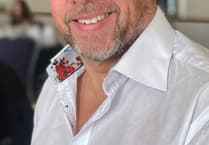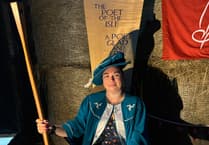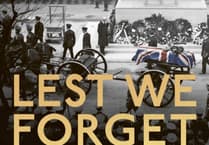Their forms seem to be actually imbued with the breath of life’ is how the Museum of Contemporary Ceramic Art in Japan describes the work of five artists whose sculptures have been chosen for their latest exhibition ’Human and Animal’.
These artists come from the United States, Finland, Japan, the UK and - St Mark’s in the Isle of Man.
So how did a farmer’s daughter whose studio is a converted outbuilding on the family farm end up having her work recognised in Japan, a country where ceramics are highly regarded, almost revered?
Stephanie Jackson, the artist in question, explains: ’I guess it all started in 2014 when I did a residency in Japan.
’I was invited to go and stay for three months in Shigaraki which is an ancient kiln site in Japan.
’The Shigaraki Ceramic Cultural Park is a specialist centre where artists come from around the world to push the boundaries of what can happen with clay.
’We went there and met artists from all over the world who work in clay. It’s there as a place where you can go and use huge kilns and the best equipment.
’Our gallery [on the Isle of Man] sponsored us to do that.
’The curator from the museum there was a primate specialist from Kyoto University and they have pulled together five artists who have been to this centre over the 20 years that they have been operating.
’The show is called Human and Animal with a sub note Life Breathed Into the Soil.’ This speaks to the fact that clay is a type of fine-grained natural soil material containing minerals known as kaolinites.
It forms as a result of the weathering and erosion of rocks containing the mineral group feldspar over vast spans of time. It is the oldest known ceramic material, used by humans since prehistoric times.
The finest clay, white clay, is used in the manufacture of porcelain and fine bone china, but the clay Stephanie uses is a much more natural-looking substance, her large scale pieces literally looking as though they were formed from the earth.
She says: ’I’ve always liked the physicality of clay, it’s the connection back to the earth and clay.
’Like no other material, it connects you to the fact that people have wanted to make things with clay since time began, it’s an ancient connection back to art and then the kiln renders these moments solid.’
Stephanie, who graduated from the Royal College of Art in London with an MA in Fine Art Sculpture, is the daughter of Peter Quayle who runs the Central Mart.
The family farms at Ballagrangey in St Mark’s where Peter breeds premium beef cattle.
Stephanie is married to Darren and they have two children, Ewan, 5, and baby Aiofe.
Between the two of them Stephanie and Darren have been responsible for some well-known and instantly recognisable large scale sculptures around the island, including the Bull for the Southern Show centenary, made from old bits of farm machinery, and the giant elk at the Wildlife Park.
They also do ice carving, including the ice sculptures on display in Strand Street at Christmas time.
Stephanie explains: ’Darren and I together are called the Farmyard Studio and I would give that credit for the bull definitely more to Darren: he did the welding and everything on that.
’Together we did the giant elk for the Wildlife Park and the big Manannan Loaghtan sheep sculpture that was up on the mountain at the festivals a few years ago.
’Darren also did the RNLI sculpture, the bronze in Ramsey, so they’re just a few examples of the different materials that we cover.’
When I suggest that making such enormous pieces must be very physically demanding, Stephanie laughs and says: ’The advantage of being a farmer’s daughter.’
She goes on to explain how she has taken inspiration from her farming childhood: ’I just feel so lucky to have grown up on a farm: it’s a daily connection to animals and a daily reminder of what we are: human, nature, animals all as one.
’It’s why I’m a sculptor, it’s the stuff of life.
’When I make a sculpture I’m just trying to bring a little bit of the essence of what it is to be animal and I hope when they’re viewed it’s a reminder, a reflection into our own souls of who we are and what we are and our connection to the natural world, which humanity is doing a good job of trying to disconnect from somehow.
’I want to celebrate the connection to nature.’
She and Darren have plans for the redundant building they have converted into their studio. She says: ’We want to be able to offer workshops and master classes, residencies even, because we get people in Japan that want to visit.
That’s the long-term plan we’re working towards.
’We hope that Ballagrangey can continue long into the future without intensifying.
’We want to celebrate it. We’re so lucky in the Isle of Man to have such fantastic produce locally with traceability, we’re just so fortunate to be able to do that here on the island and we want to continue that way.’




